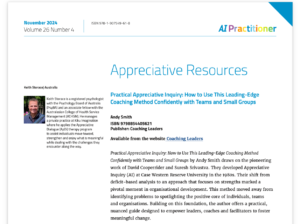The Wholeness Principle (part 1)

[ad_1]

“Wholeness brings out the best in people”
The three ‘emergent’ principles of Appreciative Inquiry developed some time after the original five, arising from what practitioners observed and found to work as they facilitated Appreciative Inquiry processes with organisations and communities. They were first set out in The Power of Appreciative Inquiry: A Practical Guide to Positive Change by Diana Whitney and Amanda Trosten-Bloom.
Increasingly, we see the Wholeness Principle elevated in books and articles about Appreciative Inquiry to have equal status with the original five principles in discussions and books about Appreciative Inquiry, reflecting its importance.
What is the Wholeness Principle? The idea is that no one person has the whole truth about a situation. In an organisation, the leadership team will see things at least slightly differently from middle management, frontline workers will have a different view again, and the customers or service users, because of their different experiences, will know truths about the organisation that no-one inside it is aware of. And, of course, the individuals in each of these groups will have their own different perspectives, adding further nuances. In order to get a wider, deeper, and richer view, all of these viewpoints should be heard from, creating a synthesis of diverse narratives. Gathering input from diverse perspectives will lead to more robust and effective decision-making, because there will be a stronger foundation of knowledge to base the decisions on.
In contrast to most other coaching approaches, Appreciative Inquiry has mostly been concerned with what happens between people, rather than focusing on the individual, reflecting its origins in organisational development. It’s easy to see how the inclusion of different voices is valuable when dealing with organisations, or even teams or families. But – you might reasonably wonder – how can it apply to individuals?
We tend to think of individuals as unitary items, who behave consistently and rationally. Western economics, for example, is only now beginning to move on from the concept of ‘homo economicus’, the mythical individual who always makes rational decisions in his own self-interest.
To say the least, this theory doesn’t always coincide with reality, and other conceptions of the self are available that perhaps are closer to the truth. For example, most people can recall times when they have acted in a way that seems inconsistent with their own image of themselves. If you’ve ever been faced with a difficult decision where you’re saying to yourself ‘on the one hand this… on the other hand that’, you’ll know what I mean. If you’ve ever felt torn between two alternatives, or done something ‘against your better judgement’, or given up smoking and then started again, you’ll be familiar with the experience inner conflict.
What’s going on here? It’s as if there are ‘parts’ of our minds which have their own ideas about what’s good for us, and which ‘seize the controls’ when our conscious attention is diverted. This is most apparent with habits like smoking or nail-biting, where we tell ourselves that we 100% want to stop but somehow it keeps happening, but it also happens in more subtle ways. How many times have you put off doing something that you tell yourself you ‘should’ do? You might say to yourself in these situations, “I wish I could motivate myself”, as if the “I” and the “self” are two different things.
More subtle again is what happens when two of your values appear to clash. Let’s imagine a person to whom ‘security’ and ‘excitement’ are both important and motivating in the context of their career. When choosing their next career move, they might feel torn between a job in the civil service (which appears to offer security, but very little excitement), or hiring themselves out as a freelancer filming great white sharks in the South Pacific (lots of excitement but no security at all). Whichever one they choose, they would have misgivings, because they believe that by choosing excitement they would have to give up security, and vice versa. They might say, “Part of me wants the security of the civil service job, but another part of me craves the excitement of the shark filming gig.”
Another way that internal divisions can show themselves is in ‘serial incongruity’. Back when I was a hypnotherapist, I had a client in the entertainment industry who told me that for six months of the year he was a complete party animal, all about booze, drugs, and casual sex; then he would transform overnight to being completely straight-edge, clean and sober, running every day and eating a macrobiotic diet. Six months later he would be back partying again, and so on, flipping between the two opposing motivations.
One way that the Wholeness Principle can inform our coaching, then, is by helping our client to reconcile inner conflicts, so they can find ways of fulfilling both values that they previously assumed were incompatible. This may not be easy, but just as in Appreciative Inquiry we assume that something is working in any situation, we can also assume that there will be a way of healing inner conflicts, or at least allowing both ‘sides’ to reach some kind of accommodation.
Another, perhaps related, application of the Wholeness Principle would be to take account of the idea of state dependent memory, learning and behaviour. This is the phenomenon where information is more easily recalled if the person is in the same state – physical or emotional – as when the memory was encoded. As well as retention of information learned, this would also affect behaviour because we make decisions on what to do based on the information available to us, consciously or unconsciously. If we recall information differently depending on the state we’re in, that’s going to affect the behaviour that makes sense in the light of that information.
Crucially for coaching, our beliefs about our own capabilities, about other people, and about how the world works, may also be affected by physical or emotional state. I know from my own experience, for example, that I have more belief in my own capability to get things done and surmount obstacles when I’ve had a good night’s sleep compared to when my sleep has been interrupted.
The ideas that a coaching client generates during a coaching session, the reference experiences that they recall that support their estimates of the chances of success, and the actions that they want to choose, may all be influenced by the state that they’re in during the coaching session. If they’re all fired up with motivation, they may over-promise and commit to actions that they can’t sustain, because they believe it’s doable at the time they say it.
The Wholeness Principle, then, suggests we should be interested in how sustainable the chosen actions are, how the client will keep going if obstacles arise or if their emotional state changes, and how compatible their choices are with the whole range of their values (which may be wider than the motivations that are front of mind for the client during the coaching session).
[ad_2]




